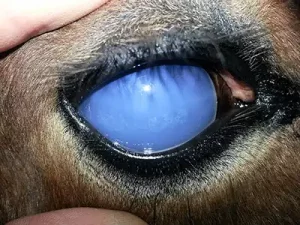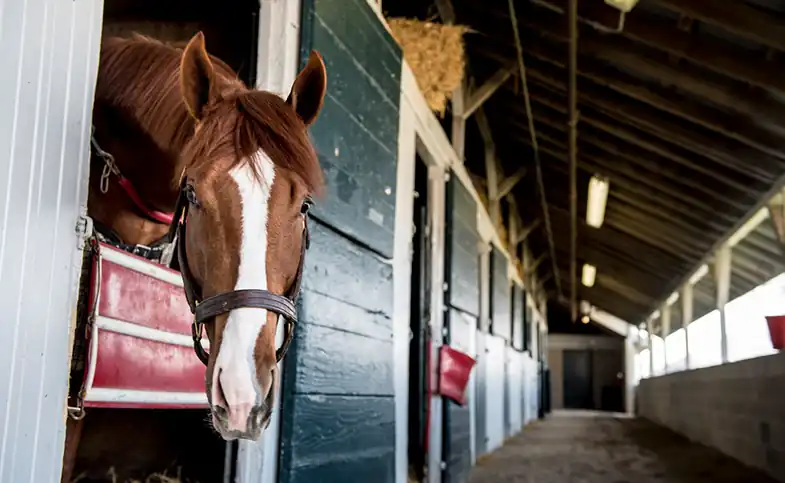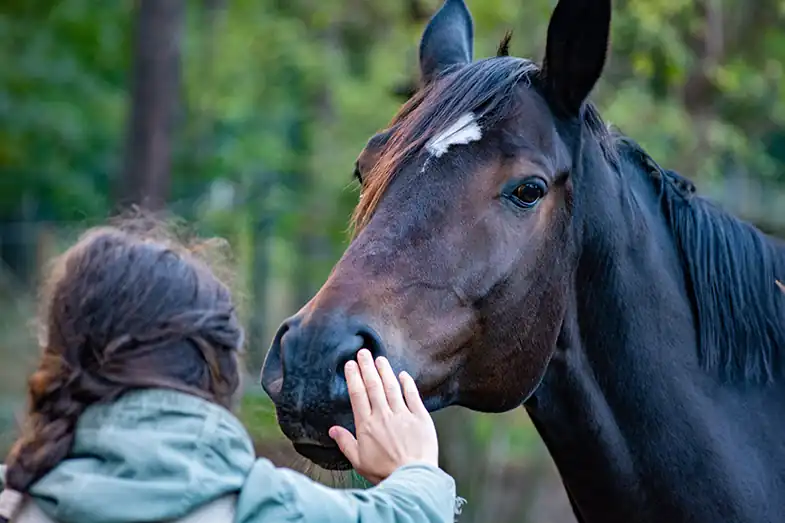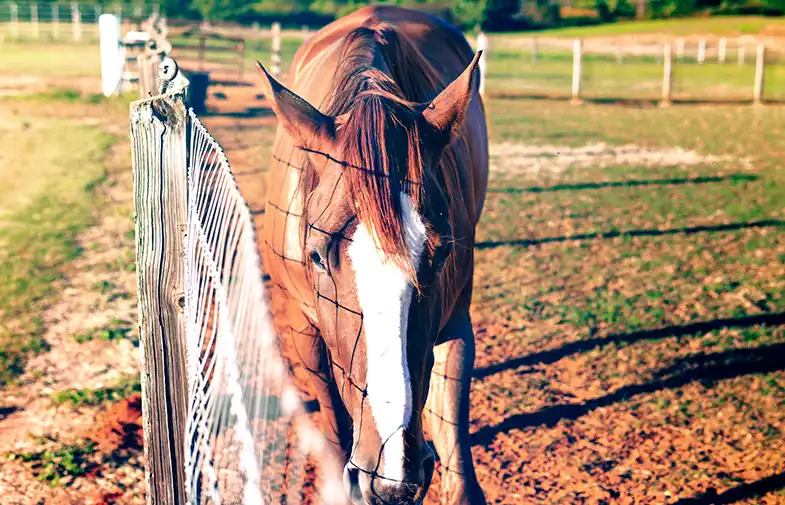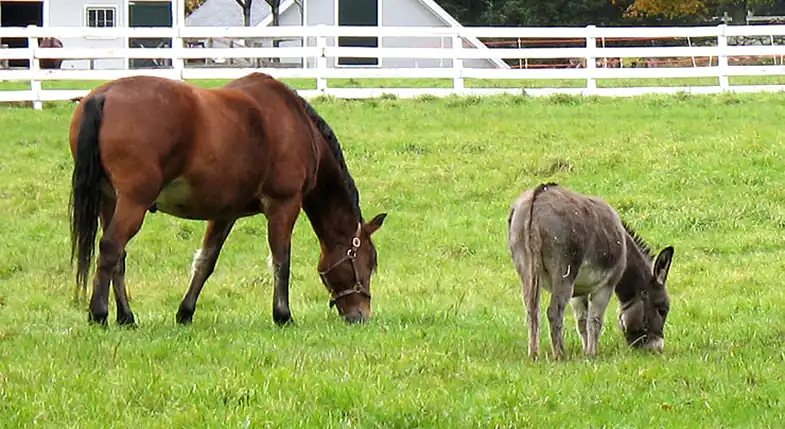Thankfully, complete blindness is comparatively rare in horses with less than 2% of all horses, worldwide, suffering a total loss of sight in one or both eyes but, while this may not be common it doesn’t make it any less distressing for your horse. It can also be an extremely stressful time for you as an owner as you struggle to do the best for your horse.
A few years ago one of my horses (a leopard spotted Appaloosa) started to show signs of blindness which, although I knew was a common problem with Appies, I was still in a panic as I didn’t know what to do for the best. Luckily I had a friend who already had a blind horse so was able to give me some advice, but a lot of it was trial and error. Eventually, I found what worked for my horse which is why I decided to write this article, to hopefully help other owners who find themselves in the same situation I was in.
How do you care for a blind horse? As a general rule blind horses don’t need any more care (or any less for that matter) than a sighted horse but they do need to be separated from the rest of the herd and ideally placed in their own paddock with just one companion.
What should I do if I think my horse is going blind?
Horses can go blind for a number of reasons but the most common cause is a condition known as Equine Recurrent Uveitis (also known as moon blindness). ERU, as it’s also known, can be extremely painful so if you think your horse is suffering from this you should speak to your vet immediately. They’ll be able to assess your horse and help to reduce the pain and possibly stop them from losing their sight completely (less than half the horses suffering from ERU will suffer from total sight loss).
If your horse loses their sight then it can be extremely distressing and frightening for them as their world is now in complete darkness. This can often lead to horses panicking and behaving in an unpredictable way, which is why it’s best to keep them stalled until they’ve adapted to their loss of sight. This will give them time to acclimatize without the risk of them hurting themselves or others.
If you’re not able to stall your horse then it’s important to remove them from the rest of the herd and place them in a small, fenced off area. The area should be smaller enough so that they can’t run into things and hurt themselves.
This will give your horse time to adjust to their new world, but it will also allow them to fine-tune their other senses (such as their hearing) in safety.
How do horses cope with going blind?
Thankfully most horses lose their sight gradually but even so it can still be frightening, confusing, and upsetting for them when their sight first goes but they are extremely adaptable and will very quickly adjust to the change.
At first, your horse may be nervous and anxious and act accordingly but this won’t last and, as they come to terms with their blindness their normal personality will return. Once my horse had gotten used to his blindness he was just the same as before, albeit slightly more careful than he was before.
All horses are different and there’s no set time for how long they take to adapt to things (some may take a few days while others a few weeks) but as a rule, they learn to rely on their other senses pretty quickly. Without the use of their eyes, a horse’s hearing and touch become far more important to them which is why you should always talk to your horse while you’re with them and touch them regularly so they know where you are and what you’re doing.
How do I care for a blind horse?
Horses are prey animals that rely on their sight to survive but thankfully domesticated horses don’t need to exercise their worry about whether or not they’re going to be eaten so if your horse feels safe (even without his vision) then he’ll have a happy life regardless of his lack of sight. That said though, your horse will need to learn where some things are, such as his feed and water as well as where the parameter fences are, but you can help with this.
Your horse obviously won’t be able to see obstacles so they’ll need to be moved out of his way but on top of that, you’ll also need to make some other changes and help your horse to become familiar with his environment. It may seem daunting at first but below is what I did to make sure my horse’s stall was safe and suitable for him.
Remove any sharp objects
You’ve probably already moved all forks, barrows, buckets, and everything else that’s normally left lying around but you may have overlooked things like hooks, nails, and even bolts. While these are unlikely to cause problems for a sighted horse, blind horses will often use their nose to feel their way around their stall so you need to remove anything that sticks out.
Feeding your horse on the floor will also do away with the need for hooks to so there’ll be less chance of your horse hurting himself on them. As an added bonus this will also help to reduce your horse’s stress and anxiety because it’s a more natural way of them eating.
While this step is important for blind horses it should actually apply to all horses really.
Show your horse where everything is
Horses have a great smell at the best of times and probably don’t need any help finding their food but I found that it helped my horse if I showed him where his food was. I did this by taking a small handful of feed from his bowl and allowing him to eat it directly from my hand. After he’d finished I then lead him over to the bucket and lowered his head toward it. As soon as he was aware of it he started eating and now knows exactly where his food is.
Keep everything in the same place
Keeping everything your horse is likely to use in the same place all of the time (even when he’s not using it) will help him to find it quickly. After showing my horse where his food was I noticed that he didn’t drink straightaway (which he normally does), this worried me at first until I realized he probably didn’t know where his water was. I quickly put it next to his feed bucket and now he drinks as soon as he’s finished eating. I also put his hay there too, after all, if he can find one thing he can find everything if they’re in the same place.
Let your horse know you’re there
From a very young age, we’re told that we should never sneak up on a horse but this is far more important for blind horses. While they may be aware of your presence they probably don’t know exactly where you are or what you’re doing which is why talking to them is so important.
The same goes for stroking your horse, touch is a vital part of horse communication but that doesn’t mean to say you should just reach out and touch a blind horse without letting them know you’re there. No matter how mild-mannered your horse is, touching him without letting him know could spook him and may even cause him panic.
I personally like to touch my horse as I walk around his stall, this way he knows where I am all of the time. Not all horses like the constant reassurance so just do whatever works best for you and your horse.
How do I make my pasture safe for a blind horse?
Some people argue that it’s not safe to turn a blind horse out and that they don’t know whether they’re inside or not but this just isn’t true. My horse certainly knows when he’s inside and he’s not, he hates being cooped up and complains bitterly until I turn him out so you absolutely can turn a blind horse out. Before you do though it’s vital that you make sure the field is safe, secure, and ‘blind horse friendly’.
Remove all obstacles
Even if you turned your horse out in the same area before he lost his sight you should still remove all objects and don’t leave anything lying around. This includes all jumps, barrels, tires, pipes, and even trailers if you normally park them in the field.
If possible you should also put any water troughs or buckets next to the fence so that your horse won’t trip over them or walk into them. If you’re not able to do this though, putting something that makes a soft, gentle noise (such as a wind chime) near the trough it will alert your horse to it, helping him to avoid it unless of course, he wants a drink.
Trim low-hanging branches
This is an ongoing task but taking time to walk around the field now (cutting back branches as you go) will make it much easier to do in the future. It’s important to remove any branches that are hanging into the field but I like to cut back ones that are threatening to as well.
At the same time as doing this, you should also remove any dead branches, these will undoubtedly end up in the field if you don’t so better to do it at the same time.
Make sure your fencing is suitable
While the fencing you have may be perfectly suitable for there rest of your horses it might not be suitable for a blind horse. The best type of fencing is any type of mesh fence where the holes are smaller than 3 inches. If your horse does run into the fence the mesh will move and flex with him in a way that’s impossible for fixed fencing (such as post and rail) to do.
If you have electric fencing around the pasture you should either remove it completely or switch it off. Contrary to popular belief, horses can’t sense electric fences and could panic if they accidentally touch it and get a shock (no matter how mild).
Fill in any holes and level off the ground
Blind horses are more likely to trip so filling in holes will help to prevent this from happening. You should also, if possible, level off any bumps and raised areas if they’re not too big. I found that reducing the height of some of the bumps meant I had enough soil to fill in the holes!
Walk your horse around the pasture
Once you’ve made the pasture safe and secure it’s time to introduce your horse to it, but before you just turn him loose you should help him to become familiar with everything.
I did this by walking my horse around the parameter, tapping the fence as I went, helped my horse to learn where the edge of the pasture was. I always tapped his water trough and allowed him to drink from it so that he knew where that was too.
You might not think that tapping things as you go will work but it helps a lot more than you might realize. Horses are great at creating mental maps of their surroundings (even if they can’t see it with their eyes) and then later using these maps to help them find their way around. In fact, they’re so good at this they can even find their way home from places they’ve never been to before.
Make sure your horse has company
Horses have a very strong social hierarchy but this is constantly being challenged with the weaker and more vulnerable horses often being bullied and chased away from food and water. This is why it’s important to remove a blind horse from the rest of the herd, although they do still need to have some sort of company.
Ideally, you should turn a blind horse out with a friendly, non-aggressive horse that it knew before it went blind but if this isn’t possible then you should start looking for a new companion as soon as possible. There’s no question that horses prefer the company of horses but if you’re not able to find a suitable horse (or pony) friend then these can make good alternative companions for a blind horse.
- Goats
- Sheep
- Donkeys
- Alpacas/Llamas
I know some people keep chickens with their horses, but while they can make great companions I don’t think they’re really suitable for blind horses. They can easily get under their feet and can be very quiet one minute and then noisy the next which, in my mind at least, makes them unsuitable for blind horses.
Can I still ride a horse that’s blind?
Once your horse has adapted to his loss of vision there’s no reason at all why you can’t continue to ride him, especially if you have a good relationship and he trusts you. That doesn’t mean you can just get on your horse and ride as normal, you should be careful and take a few precautions.
- Have somebody with you when you ride – You may never need them but its better to be safe.
- Make sure there are no obstacles for your horse to trip over or walk into – Remove things such as jumps, markers and mounting blocks.
- Wear a riding helmet & body protector – If your horse suddenly spooks and you fall off, a riding helmet and body protector will help to reduce the severity of any injuries.
- Keep talking to your horse – This is even more important that when you’re on the ground because your horse will be relying on you to be his eyes.
If you have a good relationship with your horse and they trust you then there’s no reason at all why you can’t continue to ride and even jump them, after all just look at Endo.
Related questions
How can I tell if my horse is going blind?
Most horses that lose their sight do it gradually, often without their owner noticing but there are a few subtle signs to look out for if you think your horse is going blind.
If your horse has started bumping into things, such as doorways or fencing, more than normal or is tripping a lot then it could be an indication his sight is going. If he’s more jumpy than normal it could also be a sign and you should speak to your vet for advice.
Should a blind horse be put down?
You might think that it’s in your horse’s best interest but, unless they have a degenerative medical condition that affects their quality of life, you should never put a horse to sleep just because they’ve lost their sight. Horses are extremely adaptable animals and can, in the vast majority of cases, adjust very well to losing their vision.
Are some horses more prone to blindness?
While all horses, regardless of color or breeding, have the same chance of suffering some sort of blindness Appaloosas are 8 times more likely to suffer from Equine Recurrent Uveitis than any other breed. They are also more likely to completely lose their sight as a result of ERU. The reasons for this aren’t known for sure but it’s believed that the leopard complex gene (that’s responsible for their coat pattern) plays a big role in this.
I hope you found this article helpful. If you did I’d be grateful if you could share it please as it would really help me.
Recommended products
Over the years I have tried hundreds of different horsey products, from various blankets and halters to different treats. Some I’ve loved, others I’ve hated but I thought I’d share with you my top all-time favorite products, the ones I never leave the yard without. I’ve included links to the products (which are in no particular order) that I really think are great.
- Horse Knots by Reference Ready – If you’re like me and enjoy pocket reference guides then you’ll love this knot tying guide. These handy cards can easily fit in your pocket or attach to the saddle for quick reference. They’re waterproof, durable and are color coded to make them easy to follow.
- Mane ’n Tail Detangler – Even if you never show your horse you’ll need to detangle his tail from time to time (and possibly his mane too) which is always a challenging chore! I’ve found that if I run a little bit of detangler through my horse’s tails every few days it stops them from getting matted up and makes combing them easy, even if they’re coated in mud. I don’t know if I should admit to this or not but it also works wonders on my hair.
- TAKEKIT Pro clippers – Over the years I’ve tried a lot of different clippers and while some were obviously better than others I found these to be by far the best. They are heavier than a lot of other clippers but for me, that’s a good thing, it makes them feel more sturdy and hardwearing. On top of that they have a range of speeds so are just as good for clipping your horse’s back as they are his face. I also like the fact that they come in a handy carry case but that’s not for everybody. The company that makes them is super good and incredibly helpful too, a real bonus these days. The only thing I wasn’t keen on was the fact that it doesn’t come with any oil, but that’s not a major problem as it’s not difficult to buy lubricant.
- Shire’s ball feeder – There are so many boredom buster toys out there but I like to use these every day, regardless of whether or not my horses are bored. I find that it helps to encourage my horses to problem solve by rewarding them with treats (or pieces of fruit) but it also mimics their natural grazing behavior which helps to keep them calm and de-stressed.
- Horse safe mirror – This is a strange one that many people are surprised about but I like to put horse safe mirrors in the trailers as well as in the quarantine stalls. It helps to prevent the feeling of isolation by giving the impression of other horses being around. Being herd animals horses can get extremely stressed when they feel that they’re on their own but with these stick-on mirrors, they believe that at least one other horse is with them.
- Rectal thermometer – I know this isn’t glamourous at all but it’s vital for your horse’s well-being to be able to check their temperature and a rectal thermometer is the easiest way of doing this which is why I’ve added it to the list.
Shopping lists
I’ve also put together a few shopping lists of essential items that I’ve found helpful over the years. I’ve broken the lists down into different categories rather than put everything in one massive list 😉

